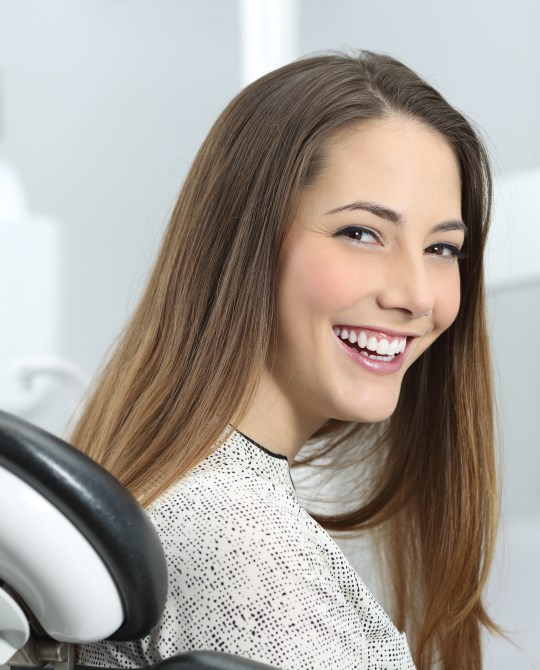Laser Therapy for Gum Disease
Dr. Crookston and Dr. Longfellow are excited to offer the most advanced periodontal treatment option available today: laser therapy. This innovative approach offers numerous advantages over traditional techniques involving scalpels and sutures.
Advantages of Laser Dentistry
Enhanced Comfort:
Laser treatment significantly reduces or eliminates bleeding, minimizes swelling, and avoids the discomfort of drilling noise and vibrations. This leads to a much more relaxed dental experience, as patients can undergo quick, effective, and nearly pain-free procedures. Laser dentistry also limits postoperative sensitivity and promotes a faster recovery than conventional methods. Thanks to the minimally invasive nature of lasers, healing begins almost immediately after the procedure.
Lower Risk of Infection:
The high-energy light beam from the laser acts as a sterilizing agent in the treatment area, which helps decrease the likelihood of bacterial infections and relapses.
Reduced Need for Anesthesia:
Since laser dentistry is virtually pain-free, the anxiety related to injections and numbness is greatly reduced. Often, only a mild anesthetic spray is necessary, eliminating the complications and costs associated with traditional anesthesia.
Applications of Dental Lasers
Dr. Crookston and Dr. Longfellow can utilize laser technology to perform a variety of procedures, including frenectomies, osseous surgery, and gum grafting. This approach not only effectively treats existing gum disease but also promotes the regeneration of healthy gum tissue. Laser therapy encourages healthy gums to reattach to the teeth by removing diseased areas with minimal discomfort. As a result, the chance of gum disease recurrence is significantly lower when laser therapy is utilized compared to traditional surgical methods.

Digital Imaging
Drs. Crookston or Longfellow chooses carefully which and when radiographs are taken. There are many guidelines that we follow. Radiographs allow us to see everything we cannot see with our own eyes. Radiographs enable us to detect cavities in between your teeth, determine bone level, and analyze the health of your bone. We can also examine the roots and nerves of teeth, diagnose lesions such as cysts or tumors, as well as assess damage when trauma occurs.
Dental radiographs are invaluable aids in diagnosing, treating, and maintaining dental health. Exposure time for dental radiographs is extremely minimal. Drs. Crookston and Longfellow utilize Digital Imaging Technologies within the office. With digital imaging, exposure time is about 50 percent less when compared to traditional radiographs. Digital imaging can also help us retrieve valuable diagnostic information. We may be able to see cavities better.
Digital imaging allows us to store patient images, and enables us to quickly and easily transfer them to specialists or insurance companies.
Digital X-Rays
Digital X-rays offer more precision since we view the image on a computer monitor, instead of holding up a 35mm film up to the light. Digital X-rays results in 1/6th the radiation exposure to you.
Laser Dentistry
For patients who do not look forward to needles, drilling, or numbness, Laser Dentistry may be the right choice.
Laser dentistry is one of dentistry’s latest advances. The laser delivers energy in the form of light. Depending on the intended result, this energy travels at different wavelengths and is absorbed by a “target.” In dentistry, these targets can be enamel, decay, gum tissue, or whitening enhancers. Each one absorbs a different wavelength of light while reflecting others. Oftentimes no local anesthesia is required. Unlike with the dental drill, with laser dentistry there is no heat or vibration, making the procedure quite comfortable for most patients. For soft tissue (surgical) procedures it eliminates the need for suturing and healing is much faster.
Lasers can be used to diagnose cavities. They can find hidden decay in teeth in early stages, and in some cases the decay can be reversed through hygiene and fluoride treatment and may never need filling.
Areas of dental care that benefit from laser technology:
- Cavity diagnosis and removal
- Curing, or hardening, bonding materials
- Whitening teeth
- Periodontal, or gum-related, care
- Pediatric procedures
- Apthous Ulcer treatment (canker sore)
- Frenectomy (tongue-tie release) without anesthesia or sutures
- Root canals and apicoectomies
- Crown lengthening, gingivectomy and other gum corrections
Dental lasers have been shown to be safe and effective for treating both children and adults.
Intraoral Camera
Many patients, especially younger patients, are very familiar with the latest technology and are comfortable with the high tech practice. Computers and TV screens are their primary method of information processing.
Drs. Crookston and Longfellow utilize Intraoral Camera technology that helps enhance your understanding of your diagnosis. An Intraoral Camera is a very small camera – in some cases, just a few millimeters long. An Intraoral Camera allows our practice to view clear, precise images of your mouth, teeth and gums, in order for us to accurately make a diagnosis. With clear, defined, enlarged images, you see details that may be missed by standard mirror examinations. This can mean faster diagnosis with less chair-time for you!
Intraoral cameras also enable our practice to save your images in our office computer to provide a permanent record of treatments. These images can be printed for you, other specialists, and your lab or insurance companies.
